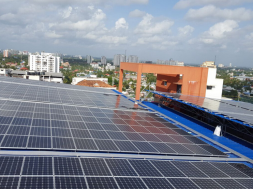
Peekaboo: NASA Astronauts Float in Space to Install Solar Arrays at ISS in Mesmerizing Video
As Thomas and Shane worked on upgrading the power supply of the ISS, they were seen orbiting the blue planet at 410 kilometres above the earth.
If you ever wondered how astronauts go about their spacewalks and perform crucial mechanical duties at the International Space Station (ISS), then the National Aeronautics and Space Administration’s (NASA) recent Tweet can give you an idea.
French astronaut Thomas Pesquet from the European Space Agency (ESA) along with NASA’s Shane Kimbrough was seen installing a solar array in the 36-second video shared by NASA on Twitter on Thursday.
As Thomas and Shane worked on upgrading the power supply of the ISS, they were seen orbiting the blue planet at 410 kilometres above the earth. The latest spacewalk focused on installing the second series of the six roll-out solar arrays (iROSA) which arrived on a SpaceX Dragon cargo ship earlier this month. The first iROSA were installed by the ISS astronauts earlier this week.
Solar arrays play a crucial role in the functioning of the ISS. The space station uses four pairs of solar arrays that absorb the sun’s energy to provide electrical power for the numerous research and science investigations conducted every day.
They also provide the energy to continue the operations of the orbiting platform. The space station is the springboard to its ambitious Artemis missions to the Moon, which in turn will be utilised as a platform to test advanced technologies for human exploration of deep space and future missions to Mars, NASA reported
There are eight arrays currently capable of generating up to 160 kilowatts of power during orbital daytime, about half of which is stored in the station’s batteries for use while the station is not in sunlight.
Each new solar array will produce more than 20 kilowatts of electricity, eventually totalling 120 kilowatts of augmented power during orbital daytime.
The remaining uncovered solar array pair and partially uncovered original arrays will continue to generate nearly 95 kilowatts of power for a total of up to 215 kilowatts of power available to support station operations once it is completed.


















